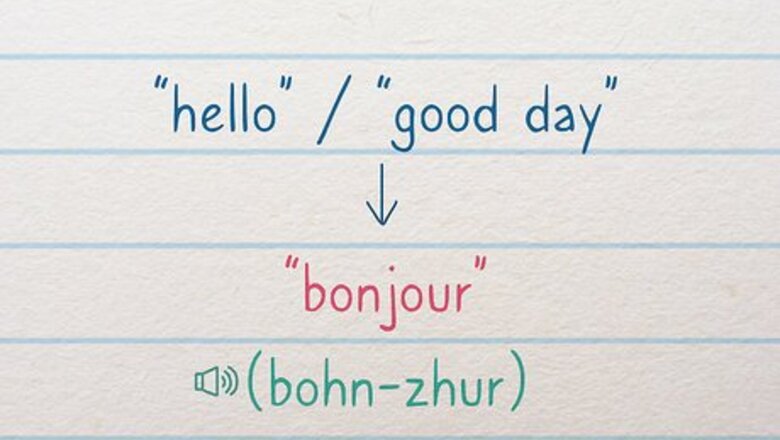
views
X
Research source
Greeting Strangers
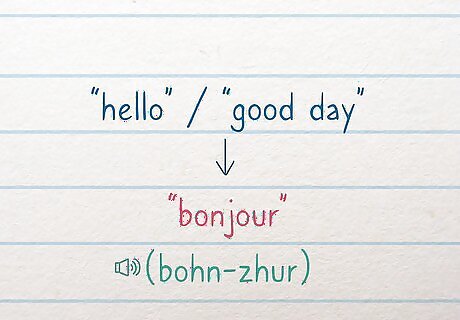
Use "bonjour" (bohn-zhur) to say hello to people in any context. "Bonjour" is the standard way to say "hello" in France. When greeting strangers, it's really the only way to say "hello." Because the French are rather formal with greetings, an informal or casual greeting would be inappropriate with someone you didn't know, particularly if that person is older than you or in a position of authority. While the word "bonjour" literally means "good day," it is appropriate to use at any time of the day. The French don't have equivalents for the English "good morning" or "good afternoon." You may already know that "au revoir" is the way to say "goodbye" in French. However, you're much more likely to hear "bonne journée" (bohn zhur-nay), which means "have a nice day." It also matches up nicely with "bonjour" (you just add another syllable), so it's easy to remember.Pronunciation Tip: The "r" at the end of "bonjour" is barely pronounced. With some native speakers, you won't even hear it at all. Without it, the word sounds more like "bohn-zhoo."
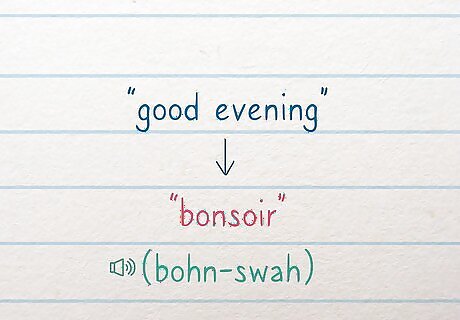
Switch to "bonsoir" (bohn-swah) in the evening. After the sun sets, "bonsoir" is a little more precise than "bonjour." This greeting literally means "good evening," and is typically used in more formal settings or when greeting people you don't know, although it can also be used among friends. As with "bonjour," there's a neatly matched phrase you can use to say "goodbye" in the evening. "Bonne soirée" (bohn swah-ray) means "have a good evening."Tip: "Bonsoir" is a relatively formal evening greeting. If you're meeting with friends and family, you would typically stick with "bonjour," even late into the evening.
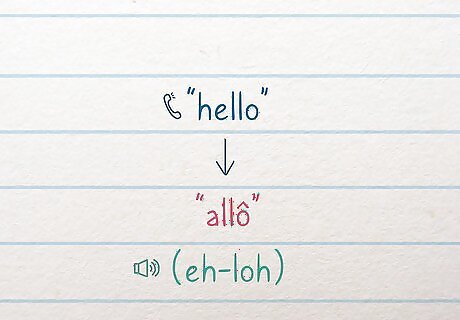
Answer the phone with "allô" (eh-loh). This greeting sounds roughly like the English "hello" with the "h" dropped off, and is only used for answering the phone. It could be considered formal, in that you don't know who's on the other end of the line, but you would never say this to anyone in person. If you are the person who called, when someone answers "allô," say "bonjour" in response. You typically wouldn't say "allô" back.
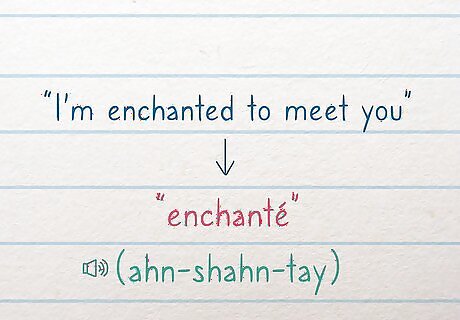
Say "enchanté" (ahn-shahn-tay) after introductions. Literally translated, this word means "I'm enchanted to meet you," but it's a common greeting after you've been introduced to someone or they have introduced themselves. It's particularly common between adults and young people meeting at a party or other festive occasion. When speaking to a woman, an extra "e" would be included at the end of the word: "enchantée." However, the pronunciation is the same. You'd only need to remember this rule for writing. Unlike other greetings, "enchanté" is only used once – when you are introduced to someone for the first time.
Using Informal Greetings
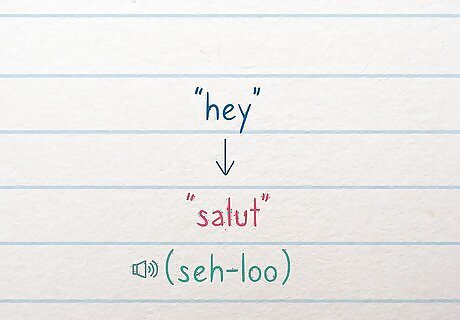
Say "salut" (seh-loo) in casual settings among friends. "Salut" is a casual, informal greeting, basically the equivalent of saying "hey" or "hi" in English. However, you would never use this greeting in French unless you already knew the person you were greeting. It wouldn't be considered appropriate to greet a stranger with "salut." "Salut" is also used if you have a basic familiarity with someone, even if you're not exactly friends. For example, if you go to the same café every morning for coffee, the barista might say "salut" to you as an indication that they recognized you from your previous visits. You'll also hear "salut" a lot on French TV shows or YouTube channels, where it is used to communicate a level of familiarity between the speaker and their viewers. When greeting a child, you can say "salut, toi" (seh-loo twah). It means "hey you," but is said in a fun, playful way.Tip: "Salut" can be used as both "hello" and "goodbye," similar to the word "ciao" in Italian.
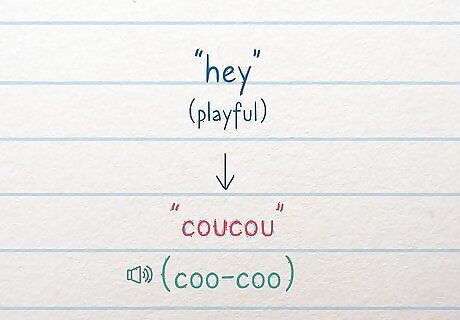
Try "coucou" (coo-coo) to be cute and playful with friends. "Coucou" is the most casual and light-hearted way to greet someone in French. It's popular among children, but many young people also use it, particularly young women. Adults also use "coucou" when they're being silly or goofy. However, remember that this is a tremendously informal greeting and should never be used with someone you're supposed to show respect to, like your teacher or your boss at work, even if you're on relatively friendly terms with them. As with "salut, toi," you can also say "coucou, toi."
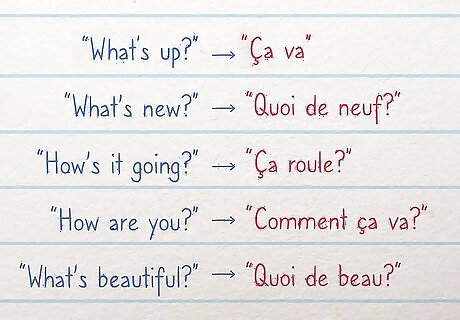
Jump straight to "ça va" (sah vah) without any "hello" first. In English, when you're greeting someone you know, it's common to simply say "what's up" or "how's it going" without saying "hello" first. The French equivalent is simply to say "ça va?" Some other ways to say "ça va" include: "Quoi de neuf?" (kwah d'nuhff): What's new? "Ça roule?" (sah roohl): How's it going? "Comment ça va?" (coh-moh sah vah): How are you? "Quoi de beau?" (kwah d'boh): What's beautiful?Tip: As in English, it's common for the French to respond by saying "ça va" (meaning "fine" or "it's going well") regardless of how they really feel.
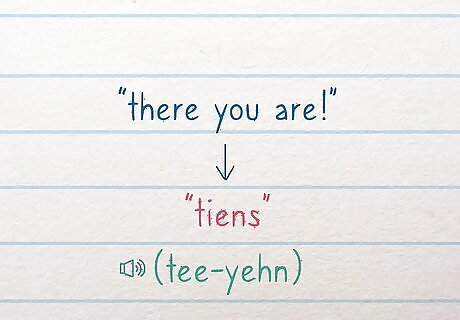
Use "tiens" (tee-yehn) as an interjection when you see a friend. When you say "tiens" as an interjection when you see someone, it essentially means "there you are!" It's also the equivalent of saying "hey!" or "how about that!" in English. You could say this anytime you see someone you're friends with. However, it's most common when you see a friend in an unexpected place, or after a longer period of time. In this context, "tiens" is similar to "voilà" (vwah-lah), which you may hear used as well.
Observing French Etiquette
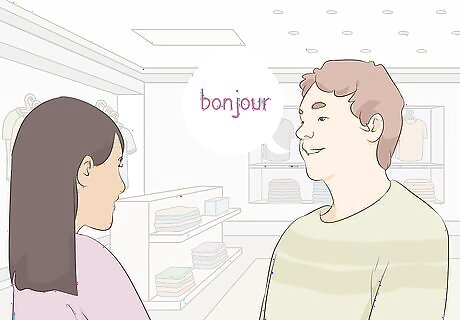
Greet people in shops even if you're just browsing. Anytime you walk into a shop or establishment, it's important to say "bonjour" to the people working there. The French consider it rude to enter a place without acknowledging the proprietor or employees. If you walk into a shop or café in France, the people working there will typically say "bonjour" to you. To be polite, simply say "bonjour" back.
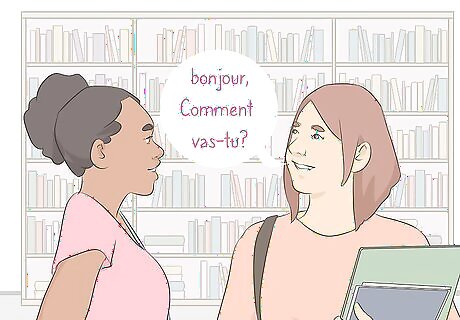
Say "bonjour" before asking any question or starting any conversation. In many English speaking cultures, the US in particular, it's common to simply walk up to someone and launch into whatever you wanted to ask. However, French people consider this rude. Acknowledge the person with a "bonjour" before you start talking to them. This goes for servers in restaurants as well. When a server comes to take your order, you typically would say "bonjour" before you start rattling off what you want to eat or drink (unless you've already said "bonjour" to them before).
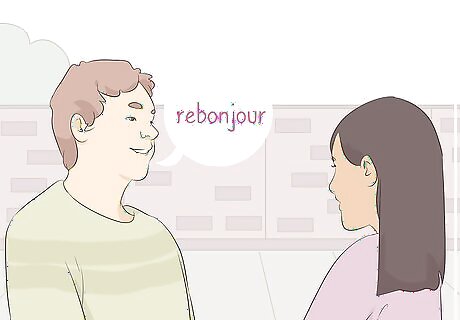
Use "rebonjour" (rray-bohn-zhuhr) if you see someone more than once in a day. The French usually only say "bonjour" to someone once per day. If you say "bonjour" to someone twice, they may think you forgot the previous conversation. If you do happen to see someone a second time, you can say "rebonjour" (literally "re-hello" or "hello again") to acknowledge that you previously spoke. Young people frequently shorten this to "re" (rray). The shortened version is more casual and should only be used with people you're familiar with.
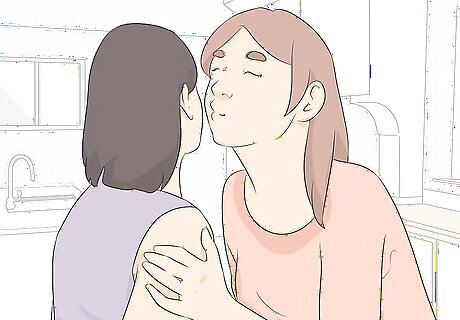
Exchange air kisses when greeting friends. The etiquette for greeting people in French varies depending on your relationship to the person and the overall setting in which you're greeting each other. However, when meeting close friends, air kisses (faire la bise) are common among French people. The specific custom varies depending on the region and local customs. While the kisses typically begin on the right cheek then move to the left, in some areas three or even four kisses are considered commonplace. Female friends are more likely to greet each other with kisses than men, although some men also faire la bise. If you're unclear on the custom, let the other person lead and try to follow as best you can.Tip: While it's common in some other cultures to hug, the French consider a hug to be an invasion of privacy. Only move into hug someone if you have a romantic relationship with them or they're a close member of your family.

Shake hands in a business setting. If you're at a meeting for work, handshakes are far more common when greeting someone. Handshakes are also common in formal settings, or when you're meeting someone for the first time. Men are more likely to shake hands than faire la bise, regardless of the setting. In some industries, particularly in the arts, air kisses are common greetings, even when you're meeting someone for the first time.




















Comments
0 comment